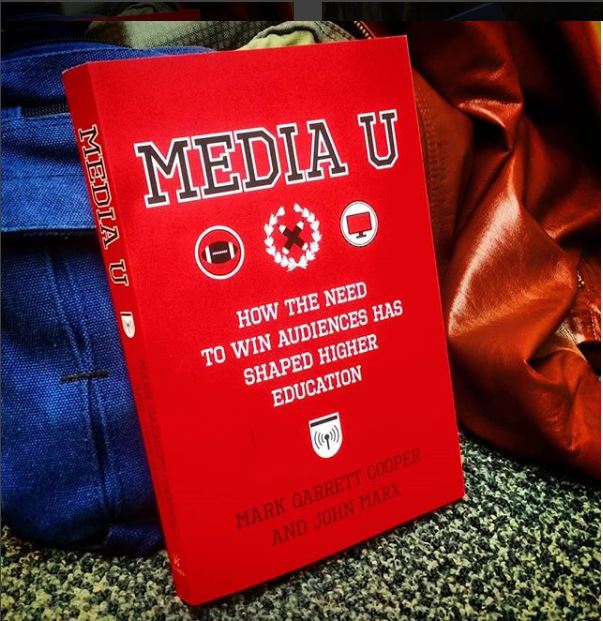Mark C. Taylor on the state of modern higher education
In a series of three articles published last Friday, Monday, and Tuesday, Mark C. Taylor, chair of the Department of Religion at Columbia University and author of Field Notes From Elsewhere, Refiguring the Spiritual, and the forthcoming Rewiring the Real among other works, addresses the negative role of the profit motive and the great opportunities offered by new technologies in American higher education.
In his first article, “How Competition is Killing Higher Education,” Taylor addresses the ways that competition in higher education “discourages risk taking, leads to overly cautious short-term decisions, produces a mediocre product for the price, and promotes excessive spending on physical plants and bureaucracies.” Drawing on examples from his own experiences with the tutoring program at Williams College, Taylor shows how much weight the various rankings systems can have for institutions of higher learning:
I’ll give an example from Williams College, where I taught for 37 years. A decade ago, the new president conducted a review of the school’s tutorial program, which was modeled on one at the University of Oxford. The tutorials consisted of eight to 10 students who met with a professor weekly in groups of two to three to discuss papers they had written. The new administration opted to expand the tutorials — a choice based on more than academics.
Williams had dropped from first to third in the U.S. News rankings, a matter of concern on campus and among alumni. One way the school could reclaim its top position was by reducing overall class size and decreasing the faculty-student ratio. When the faculty voted to increase the number of tutorials, the administration changed its accounting system without announcing it. A tutorial consisting of 10 students, for example, that met three times in groups of three or four counted as three classes. Maybe it was a coincidence, but within a couple of years Williams was again No. 1 on the U.S. News list.
Taylor also addresses the exponential rise in university construction projects:
The construction arms race on campus is the most visible example of competition run amok. To become more attractive to potential consumers, many colleges and universities undertake overly ambitious expansions. In some cases, new facilities contribute to educational programs, but too often they are tangential and trap institutions in a costly cycle: The new athletic center, dorm or student center starts to look faded when competing schools open theirs, and it never ends.
Finally, Taylor advocates for inter-school cooperation as a way to efficiently improve higher education with low budgets:
While overestimating the value of competition can lead to less, not more, innovation, underestimating the value of cooperation tends to discourage the exploration of possibilities for creative interaction. With escalating costs, limited resources and growing political concern about student debt, institutions should be developing innovative ways to cooperate that will prove to be mutually beneficial, in the same way that companies merge and become more efficient.
Taylor’s second article, “Is College’s Stone Age About to End?“, delves deeper into the question of how we can make higher education more efficient. He first addresses what he calls the “hyper-specialization” of academic departments:
While global transportation, communications and information technologies have created interconnection, academic disciplines and fields have, paradoxically, become more fragmented and isolated. Universities boast of their global expansion and vision, but they are mostly siloed institutions ill-adapted to a networked world.
While academic specialization has long been decried and ridiculed, insufficient attention has been paid to the influence that narrowly defined research has had on undergraduate teaching and the structure of colleges and universities. With online education taking off at traditional institutions, the hope is that learning breaks out of these cocoons. But as we have already discovered in the political arena, increased connectivity can create new divisions that deepen social discord. The rise of online learning may create more rifts in fields and curricula, or it may reorganize higher education for the better.
Taylor sees the lack of interdisciplinary communication and cooperation as the worst result of hyper-specialization. He claims that this lack of communication between departments is one of the major reasons that, in many cases, teaching at universities has become less important than research:
Life in the intellectual silos makes it more difficult for people working in different fields and disciplines to communicate with each other. There are always exceptions, but for the most part scholars remain in echo chambers talking to themselves. This system is self-perpetuating and resistant to change.
A familiar complaint is that as the importance of research and publication has increased, the value of teaching has tended to decrease. At research universities, prestige is often measured by how little you teach. This creates an incentive for faculty members to design courses that are closely related to their research. Many fine teachers are devoted to the needs and interests of their students, but too many courses are based on what the professor wants to teach rather than what the student needs to learn.
Facing professional pressure, faculty members are not able or eager to guide and advise undergraduate students to craft a coherent education.
In his concluding article, “College Crackup and the Online Future,” Taylor discusses how emerging technologies should and will change higher education. Distance learning and online education, he claims, can help make quality education available to a wider range of students, many of whom could not afford the current costs of traditional higher education:
Many people within and beyond the academy are skeptical about distance learning and online education. The resistance of faculty members has been the greatest obstacle to the development of effective Web-based learning. While it is true that seminars and small discussion classes can’t be taught online, they can be taught effectively using teleconferencing. Two of the most successful courses I have taught were teleseminars with the University of Helsinki in 1992 — with incoming and outgoing images of the class and myself projected onto a small television screen — and the University of Melbourne in 1996.
However effective face-to-face classes might be, the reality is that this traditional model is simply unaffordable for most students. In addition, more and more students are working and don’t have time for place-based education. Only 15 percent to 18 percent of students in post-secondary education fit the profile of 18- to 22-year-olds residing on campus. For the 85 percent so-called nontraditional students, it is necessary to develop effective alternatives.
Building on the argument he sets out in his previous article, Taylor advocates greater interdisciplinary communication in the form of “modules,” which he hopes will replace the antiquated and limiting class model in place today:
In the new model that is emerging, classes will be delivered in modules that can be downloaded as individual lectures or as an entire class and will be accessible in the data cloud. Rather than a uniformly prescribed program, students will create a diversified portfolio tailored to their interests and needs. In contrast to the standardized format, they will be able to take the whole course or, customizing, select parts of different courses and combine them in various ways.
For example, a class on contemporary art might be linked to one on current literature and another on financial markets. By connecting and layering other courses, or parts that are embedded in a constantly expanding and changing network, new insights that can’t be discovered in today’s siloed curriculum will emerge. As distribution systems change, courses will no longer be limited to the one-to-many model, where hundreds of students gather in university halls at a specified time to watch a “real” professor, but will become many-to-many conversations that allow for more interactivity.
Whether through the module method or in other ways, Taylor believes that higher education must become more nimble, more open to change, and more accepting of innovations in the way that they present material and reach students:
There is a widening gap between the rate at which knowledge is expanding and the rate at which colleges and universities change. In higher education, as in business, institutions must become more flexible and agile. Colleges and universities that can’t adapt will fail. Departments will either be eliminated or redesigned in ways that support more extensive collaboration among faculty members and students working in different areas.
These changes will meet considerable resistance, but they are unavoidable and will have beneficial results. In all areas of endeavor, innovation comes about by bringing together what is usually held apart. Just as artistic creativity often occurs by mixing different genres, so intellectual innovation frequently results from crossing different disciplines.




